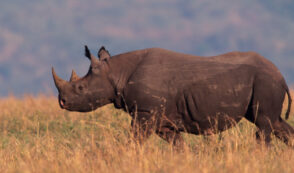Fred Myers
Fred Myers (1904-1963) was part of a dissident faction within the nearly century-old American Humane Association (AHA) who broke away to found their own animal rights group in 1954. That group, originally called the National Humane Society, would later be renamed and become the Humane Society of the United States (HSUS).
During his time at AHA, Myers most famously wrote (under the pseudonym "Jonathan Fieldston") a denunciation of hunting called "Lust to Kill," concluding that "hunting as a sport should be abolished from our civilization." That essay appeared in National Humane Review, the AHA publication that Myers edited. Myers was also known as a firebrand, trying (unsuccessfully) to push AHA toward more aggressive positions on medical research and food-animal slaughter issues.
In his younger years, Myers worked for the Associated Press, reported for the Kansas City Journal and United Press, and eventually got a job writing for The New York Mirror in 1934. By 1937, he was a full-time newspaper union organizer, later becoming chairman of the New York Newspaper Guild's "Daily Mirror Unit” when communists were engaged in a struggle to control that union. (Myers later explained to a U.S. Senate subcommittee that he was “not a Communist at that time" adding that he had supported the communist slate in union elections because “they were active and effective organizers [and] my goal was to use the tools at hand to organize the guild.”)
In 1939, Myers became an American Newspaper Guild (ANG) international organizer, leading successful labor strikes in Connecticut, Massachusetts, and Pennsylvania. The following year he became editor of the ANG's Guild Reporter, a position from which he was ousted six months later in 1941, amid a reported purge of communists among the ANG leadership the summer of 1941. (One noted communist working alongside Myers at the time was Nathan Einhorn, the Executive Secretary of the ANG's New York local. Einhorn was a Communist Party member and a major link between the Party, Soviet Intelligence, and the KGB.)
By June 1941, Myers had a job working for a Russian humanitarian organization called Russian War Relief (RWR) as its public relations director. This group's legal counsel, Duncan Chaplin Lee, was a U.S. intelligence officer later identified in deciphered Soviet cables (via the National Security Agency's "Venona Project") as a Soviet spy. By 1943, Myers was RWR's Executive Director. He resigned his position in 1946 shortly after touring the Soviet Union and being awarded the Order of the Red Banner by the Soviet Premier.
During Myers' tenure, RWR became a communist hotbed. Soviet spies involved with the organization (confirmed by NSA's "Venona" program) included board member Sergey Konenkov, his wife Margarita Konenkova (also RWR’s Executive Secretary in New York). The wife of another Venona-identified spy, Lauchlin Currie, was RWR's Executive Secretary in Washington. RWR’s Board Chairman was Marion Miloslavovich Schultz, a New York "asset" (spy) of the KGB. And the son of yet another RWR employee (the late Chicago Humane Society psychologist Saville Sax), played a role in delivering Manhattan Project atomic-bomb secrets to the Russians during the mid-1940s.
After Myers left RWR, he performed PR duties for the Institute for Pacific Relations, another Communist Party front group. He also served as Executive Director of the California-based American-Russian Institute (ARI). This group was later declared a Communist organization by the U.S. Attorney General.
Myers later testified to Congress that he resigned from ARI after “only about 2 or 3 months,” and was unemployed “for some time” while he wrote for Readers Scope magazine (another government-listed Communist publication). In reality, Myers' failed plans for ARI to merge with other regional communist organizations bankrupted the group in 1947. The Soviet Embassy appeared to be calling the shots, instructing ARI-related groups in San Francisco and Los Angeles "not to merge with the New York ARI on the theory that each was an integral cell and if the FBI got any it would get only one.”
According to his obituary, Myers was working for the American Humane Association as its magazine editor by 1950, but a more likely date is early 1952. During his time there, he persuaded AHA's board to dismiss its accountants and hire instead David Weingard, a bookkeeper who had worked alongside Myers as a "supply officer" at Russian War Relief and received the Labor Distinction Medal from the Soviet Union. After Myers later co-founded the National Humane Society (eventually renamed to become HSUS), Weingard served as that organization's financial auditor as well. According to a letter from HSUS co-founder Larry Andrews to a U.S. Senate Subcommittee, Weingard somehow learned that Myers would be subpoenaed to testify before Congress a full day before Myers himself was notified. Andrews appears to have hinted that Weingard's Russian connections included someone in the U.S. Senate with inside information.
During his Senate Subcommittee testimony, Myers denied repeatedly that he was a communist. But a month after leaving HSUS himself, co-founder Larry Andrews wrote to the Subcommittee Counsel with accusations that Myers had committed perjury. He described his motivation as a “conviction that Myers is a communist and hence an enemy of our country” and “that unless he is exposed and dismissed from his position, he will continue to dupe sincere, but gullible persons of wealth in the humane movement. I have a feeling of guilt for being the means of permitting the communists to infiltrate the humane movement. I alone am responsible for Myers being placed where he could create dissension and perhaps provide the communists with another ‘front'."
Fred Myers remained at HSUS in the role of Executive Director until his death in 1963 of a heart attack (his third). By that time, HSUS's second chief executive, Oliver Evans, was already in place in the newly created position of President.



